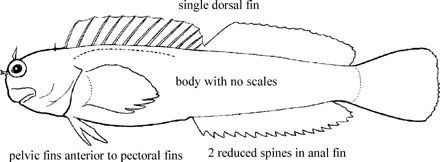BLENNIDAE
Blennies (combtooth blennies, sabertooth blennies)
By Ukkrit Satapoomin
 Petroscirtes variabilis |
|
|
Small, scaleless, often elongate fishes (most species much less than 15 cm). Head usually blunt, often with cirri on eyes, nasal openings, nape, and/or cheeks; gill openings continuous across lower surface of head or restricted to small opening on each side of head. Upper jaw not protractile; teeth incisor-like in single row in each jaw, often very fine and loosely attached; canine teeth occasionally present; no teeth in palatines; vomerine teeth present or absent. Dorsal fin continuous or notched, usually with more segmented rays than spines (III - XVII flexible spines and 9 - 119 segmented soft rays); anal fin with II spines, often indistinguishable; segmented caudal fin rays 10 - 14; pelvic fins in advance of pectoral fins, pelvic fin spine not visible externally, soft rays fewer than 5, sometimes deformed or absent. Color: very variable, dull to brilliant, full spectrum; often mottled, with irregular vertical bands or stripes, some species almost uniform.
Similar families occurring in the area. Clinidae: body with fine, embedded cycloid scales; scales with radii in all fields; many more dorsal fin spines than segmented rays; jaw teeth in more than 1 row. Tripterygidae: body with ctenoid scales; dorsal fin clearly divided into 3 parts; many more dorsal fin spines than rays; jaw teeth in more than 1 row. Gobiidae and Eleotridae: body usually scaly; pelvic fins usually with I spine and 5 soft rays; dorsal fin in 2 well-separated sections, the spinous portion with less than VIII spines, the segmented ray portion with I spine at beginning. Remarks. Mostly bottom dwelling species in sea and estuaries, usually at depths much less than 20 m, mostly among rocky, oyster, or coral reefs, often in tide pools. Feeding on a mixed diet of algae and benthic invertebrates; some are planktivores, and some are specialized to feed on skin or fins of larger fishes, with mimic as cleaner. Males attract gravid females to lay their eggs in a small hole or crevice, or in underneath empty bivalve shells. The eggs are then guarded by the male or by both parents. The family name derived from Greek, blennos = similar to mucus. |

|
|